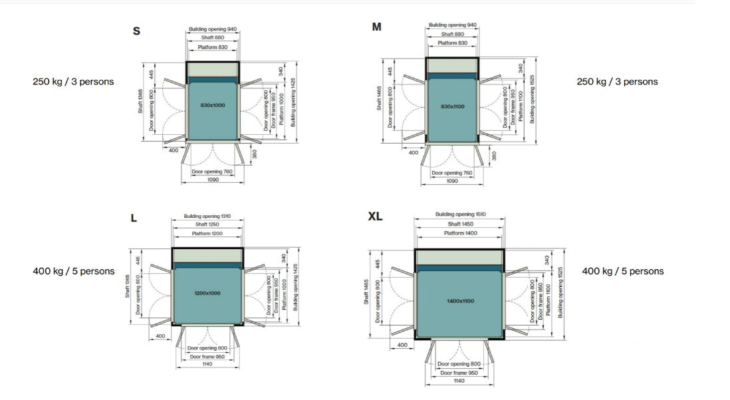
Elevator options have become commonplace when constructing homes to facilitate convenience and ease. Adding an elevator can increase accessibility and the home’s value, but it must be done calmly and intently. This blog post will discuss what modifications may be required when putting an elevator in an older home and the costs associated with the elevators for homes.
Types of Elevators Suitable for Older Homes
When considering installing an elevator in an older home, it’s essential to select the type that best fits the property’s layout and your needs. Here are three common types of small lifts for houses in Australia:
Hydraulic Elevators
Many homeowners prefer these home elevators, especially those with older homes, because of their smooth and almost silent operation. It employs a hydraulic pump for lifting and lowering the cab and is suitable for homes needing more space for a conventional machine room. A hydraulic system needs a pit at the bottom for the hydraulic equipment and a machine room at the top for the control unit.
Advantages of Hydraulic Elevators
- Smooth and quiet operation.
- Requires less headroom compared to cable-driven systems.
- It can be installed in smaller spaces.
Considerations
- A hydraulic pump is required, which may need space for installation.
- Typically more expensive than cable-driven systems due to the complexity of the hydraulic mechanism.
Cable-Driven Elevators
Cable-driven elevators are another viable option for domestic lifts, particularly for homes with a machine room. These elevators use cables and pulleys to lift and lower the cab. They are known for their reliability and are a good choice for homes with more space and structural capacity.
Advantages of Cable-Driven Elevators
- Efficient and reliable lifting mechanism.
- Lower maintenance requirements compared to hydraulic systems.
- Can be customized to fit various home sizes.
Considerations
- A machine room is required for the pulley system.
- More space is needed for installation, which can be a constraint in older homes.
Screw and Nut Driven Home Lifts
These lifts are smaller and designed for residential premises. They are flexible, as they are installed in parts, and suitable for older houses, as they require a smaller area of space and can be adjusted according to the size of the house.
Advantages of Screw and Nut Driven Home Lifts
- Space-efficient design, ideal for homes with limited space.
- Customizable to match the home’s décor.
- Easier to install in older homes with structural constraints.
Considerations
- They may have a lower weight capacity than larger commercial elevators.
- Can be more expensive upfront due to customization.

Understanding Structural Modifications
Installing an elevator in an older home often requires significant structural modifications. Understanding these modifications is crucial for ensuring a safe and effective installation.
-
Structural Support
Some older buildings may need to be built stronger to support the weight and the load required to install an elevator. Sometimes, additional weight may be necessary, so the structure has to be fixed. This could include propping up a floor, installing pillars, or altering the walls in the building.
-
Space Availability
Assess your space for the possibility of staying within the room and the structural adjustments going to be made to suit the installation of the elevator. Such assessment should incorporate the space dedicated to the elevator shaft and the space for housing any mechanical or electrical components.
-
Accessibility and Integration
When planning an elevator installation in a previously built home, it is also essential to consider how that will complement the interior. The placement of the elevator should be well considered to make it easy for users while maintaining the home’s architectural integrity.
-
Designing Aesthetics
The aesthetics of the elevator and how it integrates with the existing home design are crucial considerations. Here’s how you can ensure that the elevator complements the home’s style:
-
Customization Options
Domestic lifts have customized options to blend with the home interior design. This involves selecting the materials, finishing, and design style. It is also about choosing an elevator with a design that can complement the existing decors of older homes.
-
Consistency with Home’s Character
Ensure the elevator’s design is consistent with the home’s overall character. For example, if the house has traditional features, choose an elevator-style that reflects this, such as a classic wooden cab or ornate detailing.
-
Installation Costs
The installation cost of an elevator can vary widely depending on the type of elevator, the complexity of the installation, and the structural modifications required. Hydraulic elevators and custom home lifts tend to be more expensive due to the need for specialized equipment and installation.
-
Maintenance Costs
Regular maintenance is crucial to ensure the elevator remains in good working condition. Maintenance costs include routine inspections, servicing, and any repairs needed. Regular lift maintenance is essential for safety and longevity, and costs can vary based on the type of elevator and its usage.
SWIFT Lifts: Your Partner for Efficient Elevator Solutions
For homeowners considering adding an elevator to an older home, partnering with a reliable provider like SWIFT can make the process smoother and more efficient. We offer a range of elevator for homes, specializing in Screw and Nut Driven home lifts. Our expertise in installing elevators in various home types ensures that you receive a solution that meets your needs and enhances your home’s value.
Get in touch with us today and customize your lift model to suit your needs.
FAQs
Screw and Nut Driven home elevators are preferred over others because of their flexibility in small buildings, especially in old homes.
General servicing of the elevators involves inspecting, lubricating, and examining their safety mechanisms. Timely servicing helps avoid breakdowns. If the home is old, the elevator parts may undergo added wear and tear and thus require frequent servicing.
Installing an elevator in your home will increase its value and improve its features. It can also increase the property’s appeal to potential buyers.
The structural alterations may involve strengthening the floor and the walls and creating space for the elevator shaft and the machinery. An experienced lift company will diagnose and decide about the required alterations for safety.
You can order customized residential lifts from SWIFT that will be in tune with the overall stylistic concept of your home. Choices range from different types of materials and their finishes, as well as specific designs that would complement the mechanics of the rest of the home interior.
Get In Touch










